Incorporating
an iPhone Into Your Vehicle
I can attest to driving and
having to use my cellphone at the same time. I feel embarrassed for my
actions, even knowing that nothing tragic has come out of it. For the
safety of other drivers and ourselves, it would be great if
cellphone users could have a nearly hands-free phone experience while
driving. With
user safety in mind, this guide will show
you how to strategically mount your phone, hook up the dock connector
for constant charging, and how to connect the audio cable for both
audio playback and phone conversations. Please note that laws
regarding cell phone usage while operating a motor vehicle vary by
state.
My personal phone is an Apple iPhone 3GS which I am using in this
article. However, if you have a cellphone (smartphone or otherwise)
that has an audio output jack and a power connector jack, you can use
these same principles in this article for your vehicle and cellphone.
If your cellphone has an audio output jack but does not have a separate
jack for power; you should still be able to speak and listen to phone
calls, but the battery power will be draining as long as your phone is
not off or is in sleep mode.
Before grabbing the tools and items, you'll have to do a bit of
planning. You can put in as little or as much thought into this, but
when you set everything up, the extra planning will help you in the
long run. Anybody can purchase and install the proper cables to their
cellphone or iPhone. But from a driving perspective, would you prefer
having your phone laying in or on your console and having to
momentarily look away from the road when answering a call or changing
iTunes tracks, or would you prefer to have the phone mounted in a place
where you could stay focused on the road with your peripheral vision
checking the cellphone? Do you have the budget that allows you to
install a $60 part (and the extra cost of installation) to your
existing car stereo which allows you to connect your iPhone, or are you
the kind of person that tends to enjoy working with the physical
limitations of hardware and budgeting around that? I'll cover more on
this options throughout the guide.
PART I - COMPONENTS
Here's a list of the items you will need, (but not the items in order
for purchase):
- Compatible cellphone - iPhone (except 1st Gen) users already have
a 1/8" audio output jack, so if you fall into this category you're gold
and can move to the section "Compatible Vehicle". Some cellphones have
an odd USB or proprietary connector that handles both audio and
charging. My recommendation is to Google the cellphone model you have,
add "car audio" to the end of it, then do a search on that. You can
perform a similar search on eBay to see if any hits come up on your
search. If you get results that show a separate cable for charging and
a separate cable for audio, then you're gold and can move to the
section "Compatible Vehicle". If you get results that show a
single cable that handles the functions of both audio and charging, I
would check further on your results and see if any users have reported
any success in using their cellphones with their vehicles before
running out and getting any accessories.
- Compatible Vehicle - The way to get audio from your cellphone to
your car will make or break the process.
Option 1 - My vehicle is
a 2007 Honda
Civic EX. When I was car-shopping last year and looking for models, I
specifically wanted a vehicle with an audio input jack so that I could
then hook up my iPod Touch. The EX trim does have a 1/8" audio input
jack, so not only will any of the Apple i-series devices work, but CD
players, Sirius radios, and other MP3 players as well. So if your
vehicle already has a 1/8" audio input jack, you're a step ahead and
can move on to "Cellphone Mount".
Option 2 - A few years
ago, I had written an article for Macinstruct titled "How
to iPod your Ghetto Ride", and I had given examples of how to use a
casette adapter and Bluetooth device to get audio from the iPod to the
vehicle's audio system. If you only want to use any model iPod or
MP3 player and run the audio through your vehicle's audio
system, the "How to Ipod Your Ghetto Ride" article will still work, but
the
article doesn't hold much water if you want to utilize your iPhone or
cellphone with the audio system.
Vehicles with a tape deck installed can still utilize a casette
adapter, but the casette adapters only have a 1/8" (35mm) plug. Some
cellphones use an odd or proprietary connector (i.e old LG Chocolate),
and the audio adapters for some of these cellphones have the
proprietary connector on one end of the cable and a 1/8" audio plug on
the other end of the cable. Obviously, you can't connect two 1/8" plugs
or males together, so you would either need to purchase a
female-to-female 1/8" adapter (available at Radio Shack or Guitar
Center), or go to a specialized store or eBay to purchase the correct
cable for your cellphone that has the proprietary connector on one end
and a 1/8" jack (female) on the other end. From there you connect the
cable to your cellphone, push the casette adapter in your vehicle's
casette player, then connect the 1/8" plug from the casette adapter and
insert it into the 1/8" jack of the cellphone cable.
Option 3 - A pricier but
cleaner option is to install a small device into the back of your car
stereo. Some car radios have a proprietary connector for an external
device, while others already have RCA outputs on them. If you're not
sure about your car stereo's outputs, go to Google and/or eBay, type in
your car's year, make, model, and then add either "radio aux", "iPod",
"iPhone", or your cellphone model, and then search and check the
results: The results should describe your radio and the rear connectors:
- If your car stereo has the RCA connectors, you've got a
cheaper way of getting things to work. You can simply hook up RCA
cables to a dual RCA-to-1/8" adapter. If the adapter has a 1/8" jack
(female), you can purchase a standard 1/8" male-to-1/8" male cable,
then connect it between your cellphone and the adapter. If the adapter
has a 1/8" plug (male), then you'll need to purchase a 1/8" male to
1/8" female cable, then connect it between the adapter and the
cellphone.
- If your stereo only has the only proprietary connector, check
eBay with the same search criteria and see if a device is available for
your vehicle. Usually the device will have cables or a connector that
attaches to the rear of your vehicle's stereo, and the device will have
a cable or connector with a cable with RCA plug or jack, or a 1/8" plug
or jack. Some of these devices will not only allow audio from the
iPhone to go to the audio system, but the music titles from your iTunes
playlist on your device will appear on the stereo's display. Keep in
mind that you'll have to either install the device yourself or pay a
professional for the work, which will involve getting behind the
dashboard. Sometimes this option is available directly from the dealer,
but again, you pay a high installation fee.
Option 4 - If you've never
been happy with your vehicle's stereo, the last options is to simply
upgrade it to an aftermarket model. I believe all aftermarket models
now have a 1/8" audio input jack to accomodated iPods and MP3 players.
Again, Google your car's information to see if this is available. With
some models, you'll have to replace an entire dashboard component, but
with others only the radio portion is displaced while the other dash
components are untouched.
- Cellphone mount -
Cellphone mounts vary in size and features. Some have a suction cup
windshield mount, some use the same type of mount but grab on to your
dashboard, while others mount to the vents using plastic hooks. I had
used a windshield mount on my Honda Civic in the past, but extreme heat
and cold changes
caused the windshield to crack (along with a $250 insurance
deductible out of my pocket). I personally like the vent mounts as some
can be removed
and repositioned, plus they don't create any visual obstructions
through the windshield.
Does your cellphone have a case? I've seen some cheaper mounts on eBay
where the part that holds the iPhone is molded to the back of the
chassis for an exact fit. This doesn't bode well for users like me that
have their iPhone in a protective case. Make sure that the model you
like can accomodate a phone with a case, especially if you plan to
purchase a case down the road. If you do a Google or eBay search for a
vent mount for your specific model of cellphone, you may be limited in
your results. If you search for a universal mount, you'll find a lot
more results. Getting a universal mount is a better choice if you
decide to upgrade your current cellphone in the future, so you won't
have to switch out all your cellphone accessories later down the line.
I've used a handful of mounts for a few years. Some were chintzy and
didn't hold well while others got the job done but were not
structurally sound. So far the one I've fallen in love with is by
Bracketron (product placement ahead):

This beast only cost me $15 locally (K-Mart) or you can get it directly
from Bracketron. It's got so many features
and installing it was easier than any other mount I've used. On my
previous mount, the teeth on the clips to attach itself to the
dashboard came loose and caused the mount to wobble. On this model,
there are spring-loaded clips to the rear of the clip teeth, so once
it's attached it stays attached. When I place my iPhone in the holder,
the swing-out arms with rubber tops hold the phone vertically and
prevent it from sliding out. This also means that the iPhone dock isn't
obstructed and I can connect the cable from the cigarette outlet to the
dock. The big arms that secure it horizontally can be widened
horizontally for larger items and can even be placed higher or lower as
a whole. This means that other cellphones with side-ports shouldn't be
obstructed when a cable is connected. Of course, you'd want to get a
good look at whatever mount you choose beforehand, match it up with
your cellphone, and see if any cables coming out of the cellphone will
be obstructed by the mount. Are there free spaces above? Below? On the
sides? If you can connect a cable to your cellphone and run it behind
the mount, the mount may be worth picking up after all.
Because of scenarios like this, it may be better to purchase from a
brick-and-mortar store instead of purchasing online. In any case, check
with the seller about their return policy in case the mount doesn't
work or fit. Sometimes, you get what you pay for. If you're looking for
high-quality mounts, another brand to look up is Scosche Industries (www.scosche.com).
- Audio cable and adaptors - Simple 1/8" (35mm) audio cables are
easy to come by, but
the more expensive ones don't always equate to the best option. I had
purchased a retractable 1/8" cable from Five Below, but the audio
seemed to cut out intermittently between bits of static. After that I
had purchased a standard 1/8" audio cable from Dollar General for $4
which resulted in no noise nor cutouts at all. Again, check with a
store's return policy if buying from a brick-and-mortar store. You
won't need an excessive length of cable, as any excess can be bundled
with a velcro strap or tie.
If you fell into one of the earlier categories above which required an
adapter,
you still want to check for quality. Dual RCA-to-1/8" adapters are
pretty solid, so there's no concern there. However, I would avoid
purchasing the cables that are dual RCA and merge to a 1/8" plug. Most
of them are too short to reach from the back of a car stereo to the
front of the dashboard anyway. Making it into two pieces (RCA cables to
RCA adapter) or three pieces (RCA cables to adapter, adapter to
separate 1/8" cable) makes things cheaper and easier if one component
fails and only a single component needs replaced.
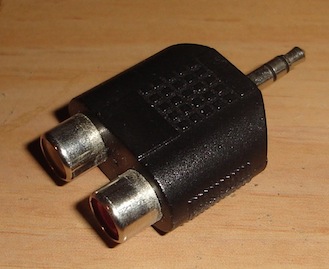
This is a dual-RCA to 35mm adaptor. For vehicles with RCA jacks; you
would connect 2 RCA cables from the car stereo to this adaptor. You
could simply connect the 1/8" plug at the end to your cellphone or
iPhone, but with this plug sticking out it might be a better idea to
get a 1/8" to 1/8" extension cable, put the jack from one end of the
cable to this adaptor plug, and the other end of the extension cable to
your iPhone.
When shopping for any types of audio adapters, there's a physical
difference between mono and stereo, as seen in the diagram below:
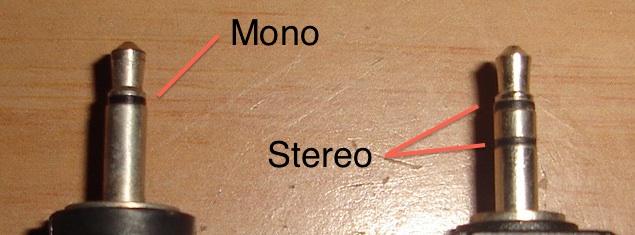
The mono end has a single black band, but the stereo end has two black
bands. This same difference is also used for 1/4" guitar cables and
patch cords.
- iPod/iPhone USB cable - This device comes standard with your
iPhone, but you can buy extras from almost any store for a few bucks.
Does your iPhone cable have an elongated, older style connector or a
shorter, newer style connector? Purchasing the same type of cable that
came with your iPhone will ensure a better chance of compatibility. If
your car came from the factory or dealer with the iPod option, you can
simply connect your iPhone or iPod to the built-in connector and the
audio from the device should play through that connector. My wife has
an '09 Subaru Impreza with this option, and she can change songs and
playlists with the buttons on the car's stereo rather than fidgeting
with the iPod iteself.
- USB cigarette lighter
connector - This is the piece you'll need to keep the phone
charging/charged the entire time you're driving. You don't want to be
on a long car trip, waiting for a phone call while your device isn't
charging; only to get the phone call you've been expecting and have the
phone die on you because it wasn't charging. If you mistakenly leave
your lights on when you exit your vehicle, then come back later to find
a dead battery and your dead cellphone, you're really up the creek!
You can purchase a car charger for your cellphone from your carrier's
retail store (AT&T, T-Mobile, etc), but you usually pay a higher
price for it than if you were to purchase the same car charger from
eBay, Big Lots, or a discount store. Some chargers work better than
others depending on the vehicle. Last year I had purchased a car
charger for my iPod Touch charger from Five Below. It worked well in my
Toyota Corolla, but when using it my in Honda Civic with my iPhone, it
only charged it to 25%-50% and then stopped. Recently I purchased a
universal USB car charger from Five Below for $4, and it fully charges
my iPhone in my Honda Civic.
Some cellphones have a specific cable that goes from their phone to a
USB plug. This allows the phone to be connected to a computer via USB.
With this, you may be able to use a standard USB car charger. Other
cellphones have a specific type of port, but there are chargers
available that have the car cigarette lighter plug on one end and the
phone's specific port type on the other end. As stated before, I
recommend checking a store's return policy before purchasing a car
charger in the event that the charger does not work.
You don't need a mount for this to work, but
it keeps the driver safer with his or her eyes more on the road than
looking down at their cellphone. You may not need a charger either, but
if you
aren't using the cigarette lighter socket for something else and you
have a few bucks, it's worth purchasing. If you are in fact using the
socket, you can purchase an adaptor which can give you two or more
sockets instead.
PART II - INSTALLATION
The fashion in which my iPhone is incorporated is such: I have the
mount on my left vent. The audio cable comes out of the 1/8" jack from
the dashboard, is wrapped by a tie due to excessive length, goes to the
mount, then is tied to the mount on the right side, and dangles in the
back left side. The reason for this is so the cord doesn't fall
elsewhere and simply stays in the same place. When I want to connect
the audio cable, I know where it is. The power connector comes out of
the cigarette
socket, tilts at a 45° angle, goes over and behind the steering column,
then gets draped behind and to the left of the mount. It's not tied
down because getting the connector to the dock involves tilting the
iPhone on it's back, and with the power connector not tied down I have
an easier time connecting it when I get in my car. Previously I had the
car sitting on top of the center console when the roll-up lid was
covering the cupholders and the power connector was connected to the
center console. Still, this meant that I had to look down and to the
right whenever I was checking my location on the GPS, seeing who was
calling me, or looking down the list for the directions I had given
myself in Notes. Not safe at all...
Before clamping or screwing anything down, I looked at ergonomics. If I put the iPhone in the left center
vent, it would be closer to the rest of the controls, but it would
block other controls of the stereo system. If I put my iPhone on the
left vent, it would be less
distracting in my line-of-sight, but would the cables reach?
These are some things you'll need to put into perspective before
securing anything. It's nice to have things clean and out of the way,
but the priority is safety and accessibility. Just as the iPhone is
designed for simplicity, you want your iPhone or cellphone within easy
reach of it's controls without blocking or obstructing access to those
of your car's dashboard. Here's a shot of my dashboard:

If I placed it in the middle left vent, the iPhone would be partially
obstructed by the steering wheel, and placing it in the right vent is
simply too far away to be convenient. In the photo below, the cigarette
outlet and the audio output are next to each other:
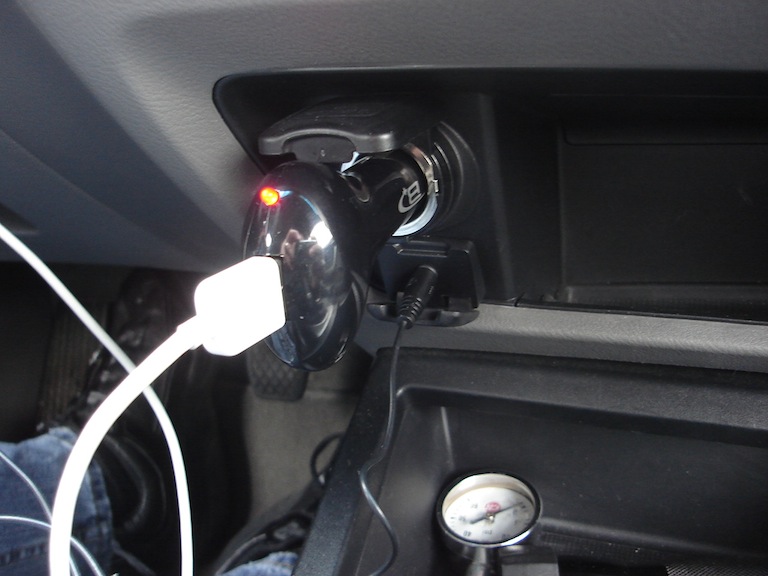
Next, I have both of the wires sitting on and behind the steering
column:
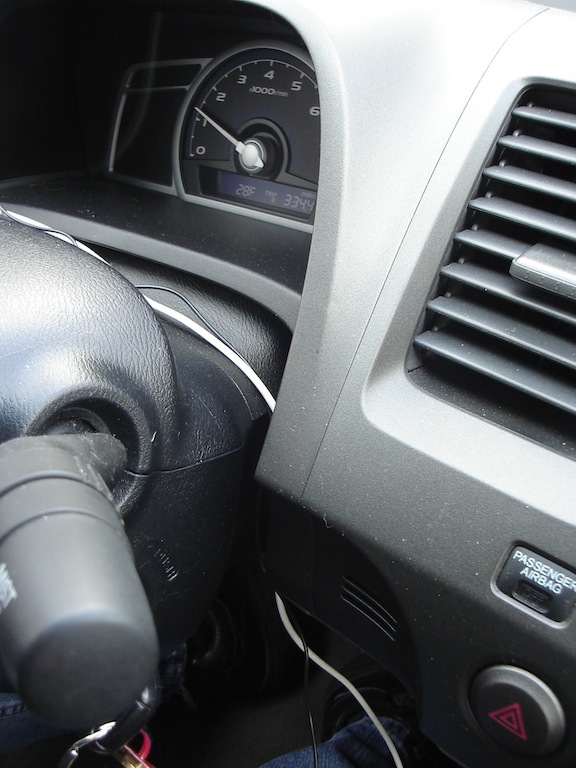
I have the bracket placed on the left vent facing me. Wioth this
Bracketron model, there's a tightening screw behind the removable
plate, so I was able to adjust it in position first, tighten it, then
slide the plate on:

Once it's connected, I can turn on the power and see the home screen:
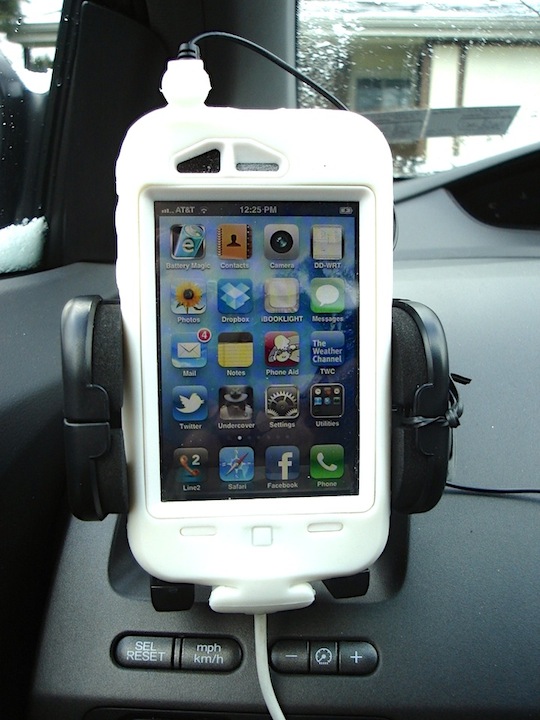
After that I can hit the phone app and change the screen to the keypad:
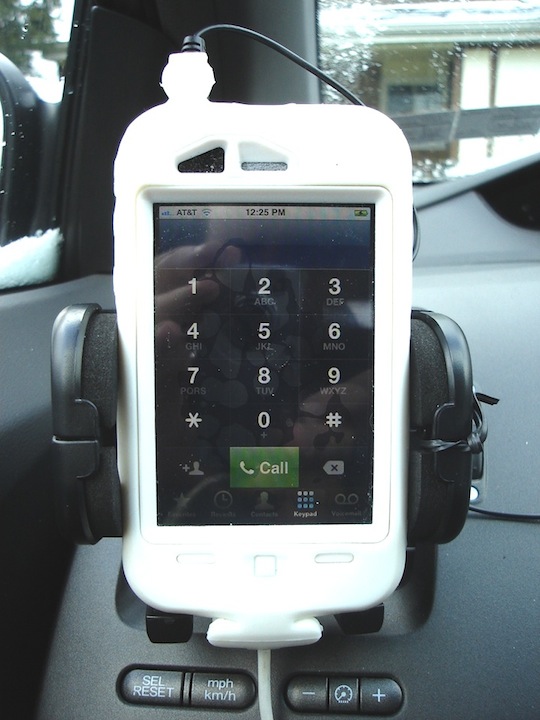
In normal usage, here's how the view looks when I'm looking straight
ahead from the driver's seat:

There's no visual obstructions from the upper left hand side where it
was previously mounted before the windshield cracked, no visual
obstructions in the center where I occasionally see some GPS devices
mounted, and I can still make and receive calls without the aid of a
BlueTooth earpiece. Now all that's left is to clean it up with a bit of
wire wrapping.
PART III - USAGE
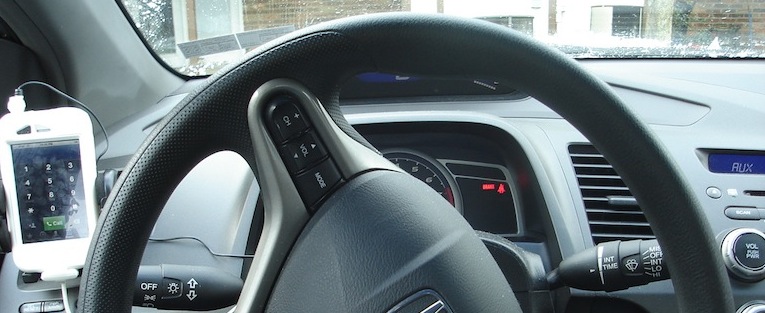
When I start my car, I can
slide the button on the iPhone screen to awake it from sleep. From here
I can start Line2 or the iPhone's own Phone app. From the steering
wheel using the MODE button, I can choose the input for my audio. This
cycles
from FM1 (six preset stations), FM2 (six more preset stations), AM, CD,
and AUX. Most of the time I'll have an MP3 CD playing in the car's CD
player, but if I wanted to I could switch it to AUX, then launch the
music app on the iPhone to play any of the song files from my iPhone
into the car's stereo system.
Here's where the fun begins:
With the input set to AUX,
I could make a phone call and speak out loud and hear the person
clearly on the other end. If I couldn't hear them loud enough I would
turn up the volume dial on my Civic's car stereo. When making
the call, I didn't have to press anything on my iPhone to activate the
speakerphone function! In addition, there was never and feedback or
howling on the caller's end or my end during a phone call. (Howling is
the audio effect you get when you're recording something an place the
microphone closer to the speaker that creates a feedback loop. That's
also a great way to annoy babysitters, as I found out at a young age).
If I ever had to take a phone call on the road, speaking was only a few
button presses away; maybe one button press on the iPhone to accept the
call, and a
couple button presses on the input selector on the steering wheel to
switch from
whatever input I was using to AUX. I
could still concentrate on the road while speaking on the phone, but
the best way, hands down, is to simply pull over to a safe spot and
them resume the conversation.
While going on interview, I now had the ability to use the GPS
functions from the Maps app or similar apps to show where I was an
where I was going. With Maps, if you plot a course you have to press
the upper right arrow button whenever you move from one minor direction
to the next, so there are still some limitations. I would overcome this
by either memorizing my route ahead of time, or simply pulling over to
a parking lot or waiting until I got to a stoplight before hitting that
button. However, you can also type in your destination and hit "Route"
without hitting "Start", and the overall route will appear on the map.
The primary phone app I use is Line2 (formerly toktumi --
www.line2.com). This
app allows iPhone, iPod Touch, iPad and Android users to make phone
calls from a WiFi point for $10 a month, and they give you a phone
number so that others can call you. When I'm in the house it just
latches on to my wireless router and I can make and receive phone
calls. When I'm driving, any incoming phone calls go through Line2's
gateway and I can receive them with the app. If I get a call from the
line that AT&T gave me, It comes up as an alert and I simply click
"Answer" to get that call through the iPhones normal phone app.
In addition to the map and phone apps, I have an entire page on my
iPhone dedicated to road applications:
- AAA Discounts - Shows
discounts given by retail establishments for products with an AAA
Membership
- Beat The Traffic -
Gives alerts and updates showing current weather congestion close to
your location
- GasBuddy - Provides a
list of the cheapest gas prices around your location by distance and
price
- MultiCam Pittsburgh -
Shows you PennDOT cams around the Pittsburgh area so you can see
traffic jams ahead of time
- GPS Drive - More than a
GPS, this shows you restaurants, hospitals, airports and other things
around the area
- Park PGH - Currently
shows the current vacancies of selective downtown parking lots which
garages are full
- RepairPal - Gives you
common estimates on your car's part cost and installtion cost
- Trapster - Points out
current places in your area where you're likely to encounter a speed
trap
- UrbanSpoon - Ratings
and reviews for restaurants
- 5-0 Radio - Turns your
iPhonie into a scanner that allows you to listen in on police-band
radio, locally and internationally
- Theater - Gives lists
of what movies are playing in your area and at which theaters
Now I've got a full list of
applications to aid me wherever I'm going,
and I can still call home safely!
Here's a website list of the vendors mentioned:
Bracketron - www.bracketron.com
Monoprice - www.monoprice.com
Scosche Industries- www.scosche.com
Line2 - www.line2.com










